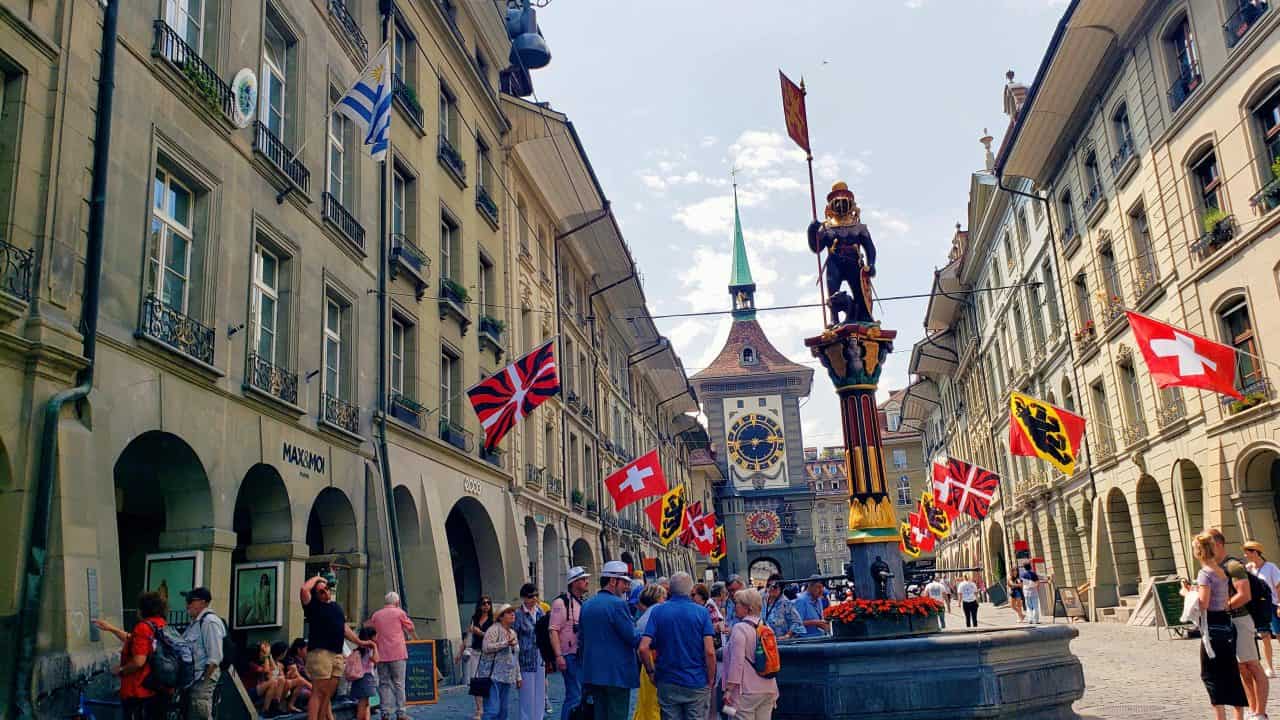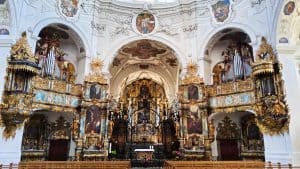Switzerland (2 of 2) Fun times

On my To Do list for the western/German portion of Switzerland was to visit the “Top of Europe” at a height of 11,333 feet (3,454m). The “Top of Europe” is Europe’s highest railway station near the top of Jungfrau mountain. I had warned Mike that this would be expensive. What I thought was the price of a round trip ticket turned out to be the one-way price. What percentage of people buy one-way tickets to the top of a mountain? Driving part way up the mountain would reduce the cost to $650 Canadian for Mike and I. This is for a 45 minute trip up and then back to the car with a stop at the top. Given my leg status, we weren’t going to go hiking too far from the train station once we got to the top. I knew that Mike wasn’t excited about the trip in the first place, so we decided to cancel it and go into Interlaken. From there we took the funicular railway up to a sightseeing platform at Harder Kulm in the mountains. That’s where we took the picture of Mike at the top overlooking Interlaken.
Mike and I had an audio tour of Interlaken that was fun to take except it took you on a straight line and didn’t return to the start. Even though the town isn’t that big, my ankle had had enough by the time we finished the tour. It would be another 1 ½ kilometers back to the car, so I sat in an outdoor café enjoying life while Mike went to get the car. He took longer than I expected because enroute he stopped to watch many different parasailers landing in a park. Swiss chocolate was certainly on display in this town.

Often we come upon gems without expecting them at all. Solothurn was one such gem. Mike and I had spent the day in Bern (more on that soon) and coming home our 80 minute drive was predicted to be over four hours due to a major issue on the highway. There was an alternate route that would take two hours which was longer than I wanted as it was already 6pm (18:00h) but much better than a four hour drive. On the way home we passed a really large cathedral in a town just off the main road. I got Mike to find somewhere to turn around and go back. We were so glad we did. Solothurn was a great town, both old and new, clean and with enough restaurants to have choice without them being overpowering. There were way too many churches for the size of the town. The interior of the cathedral that had caught our attention from the road, was gorgeous; clean, bright and white with huge paintings all around the church. Just lovely.
Interestingly, Switzerland, with its 4 national languages, none of which are English, was the most English speaking country we have visited so far.

I mentioned in my last article that we were going to Bern largely because it was the capital city and we felt like we had to. We had been looking forward to seeing Basel more than Bern. Well, am I ever glad we went. We certainly preferred Bern to Basil. Basil was nice, Bern was much nicer. Bern is known as the “City of Fountains” with over 100 public fountains in just the Old City. I will say that many of the fountains were quite different from the large, elaborate stone ones we are used to seeing. Each fountain, with its drinkable water, had a statue mounted above it. The statues were originally wood but have been replaced with stone. They have been painted and still looked like wooden statues to me. The statues included Biblical characters, historical figures and folklore warriors, often brightly painted and recounting stories of the city. Some of these statues are over four and half centuries old. Some are a little strange. One statue depicted an ogre eating a child with a bag of children at his side. Weren’t the Brothers Grimm German?
The street in the picture above is Kramgasse, which is one of the main streets in the historic center of Bern. The Zähringerbrunnen Fountain in the middle features a statue of a bear which is where the name Bern comes from. The smaller picture was in front of the church and represents Moses with the Ten Commandments. Moses is portrayed with two horns on his head, the bible says that after meeting with God the skin of Moses’ face became radiant. Apparently, during the Middle Ages, it was standard to depict Moses with horns on his head as a way to represent his radiant skin. How different that is from today’s interpretation of horns.

We visited Zurich a few times, partly because I couldn’t walk the entire self-guided audio trip in one visit. My leg is definitely getting better but it certainly isn’t where I was hoping it would be. Sometimes, if I don’t finish a tour, Mike continues on his own and sometimes we just skip the last part of the tour. We certainly are missing our bike rides. We did start with a bus tour in Zurich but Mike was tired and we didn’t really appreciate it.
Another place we visited was the Principality of Liechtenstein. We had never been there before. The entire country is about 25 kilometers (15.6 miles) long and 6 kilometers (3.75 miles) wide. It borders Switzerland and Austria and is surrounded by mountains. If you want to drive from the south to the north like we did, you have to work at staying in Liechtenstein. The main highway parallels the border but is on the Swiss side. Some other facts you probably don’t know, and which I didn’t: The population is currently less than 60,000. The capital city of Vaduz has about 5,700 residents. More people than that are about to move into the new development in the small community where Mike and I live on Lake Ontario. You can see from the picture here that they like their flowers in the capital city of Vaduz. We had a really interesting conversation with one young lady who was working in her mother’s restaurant. She spoke fluent English although her mother did not.
I have to tell you a little bit about the history of Liechtenstein because it fascinated, or maybe just amused me. In the 17th century the key governing body of the Holy Roman Empire was called the Imperial Diet or the Reichstag. The Liechtenstein family really wanted the power a seat in the Reichstag would give them. At the time, the House of Liechtenstein was relatively small and they did not possess a significant territorial base within the empire which was a requirement for the Reichstag. Their ancestral lands were located in Austria and Moravia. So how did they solve this? In 1699 and in 1712 they bought Schellenberg and Vaduz and in 1719 Charles VI of the Holy Roman Empire united the two areas and raised them to a principality with the name Liechtenstein. Since then, the Liechtenstein family has held the hereditary title of Prince of Liechtenstein. The Liechtenstein family got what they wanted yet NONE of the Princes of Liechtenstein set foot in their new principality for over 120 years!!!
Two years ago in Czechia, Mike and I had such a great day that I wrote a post, A Bicycle Ride to Remember, and made a video, A Day Cycling in Czechia, just about the one day. We saw the magnificent chateaux in Lednice and Valtice. We also saw various follies, temples and more in the woods while cycling between the chateaux. The following day we biked to the Chateau Mikulov. All this was owned by the House of Liechtenstein at one time and was their principal residence, even after becoming the Princes of Liechtenstein.

Mike and I didn’t just travel to the well-known cities in Switzerland, we spent quite a bit of time in the countryside enjoying the smaller and more rural towns. We had to do our exploring by car instead of bike, but I guess that let us get further afield. The picture above is Mike in the mountains, in the town of Rapperswil, above Lake Zurich. The picture to the side is the beautiful abbey church in Muri, an old town also not too far from Zurich.
Since last summer, the plan for Mike and I has been to spend most of this year in Germany, we just didn’t want to be there in March when it was cold. A little while ago we had thought that we might meet up with friends on their Rhine river cruise on Canada Day. Now it looks like they will finish their entire river cruise possibly months before we make it to the Rhine in Germany. Our plans are a little fluid. We are making a slight detour and heading into the Austrian panhandle or Tyrol next. We are going to camp in the mountains near Innsbruck and then head north into Germany. We spent a lot of time in Austria but it has all been in the main portion of the country and it would be nice to see Tyrol now that we are this close.
I wanted to finish this post with this picture of the phenomenal plaster work at the entrance to the cathedral in Bern. This completes our time in Switzerland for this trip. At least we think we are finished with Switzerland for now, but you never know.







Leave a Reply